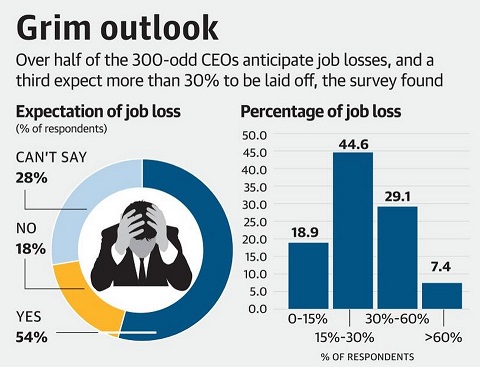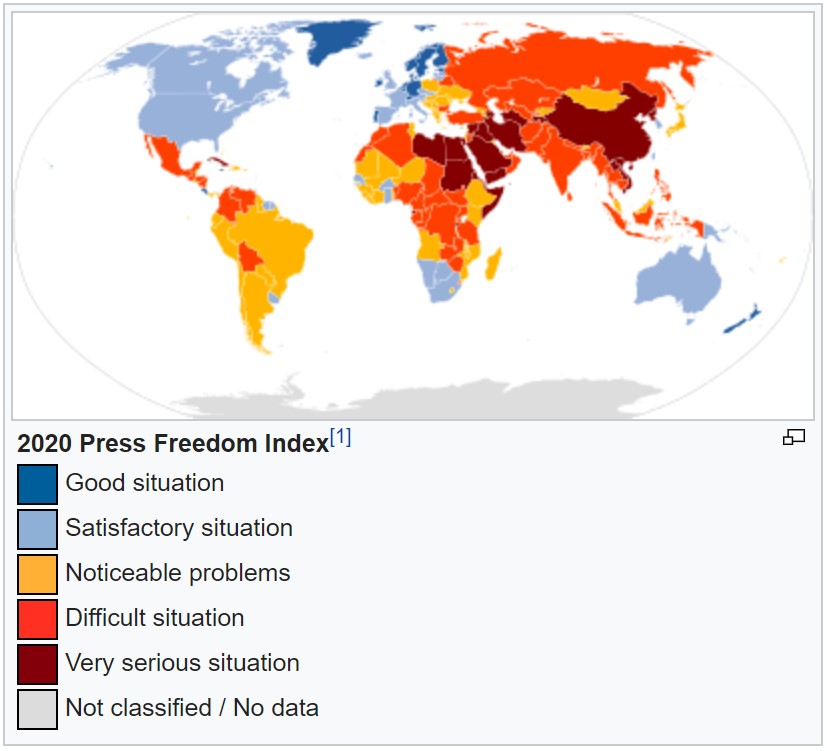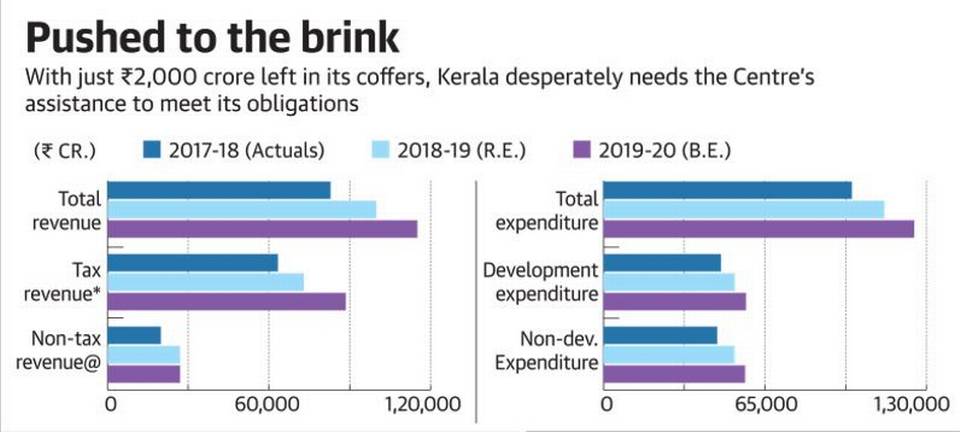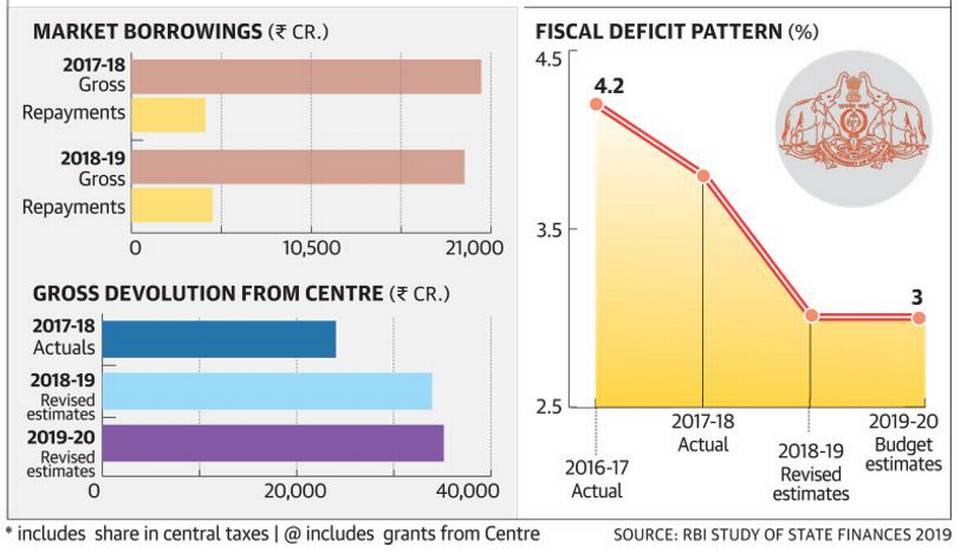Contents
- CII proposes different rules for top priority districts
- India slips in press freedom rankings
- Kerala scrambles for funds as Centre tightens
- Saudi Arabia’s investments in India on track
- Noted poet Nisar Ahmed passes away
CII PROPOSES DIFFERENT RULES FOR TOP PRIORITY DISTRICTS
Focus: GS-III Indian Economy
Why in news?
The country’s high performing economic districts should be allowed to play by different rules in the third phase of the lockdown beginning 4th April, according to the Confederation of Indian Industry (CII).
Concerns with Economic Recovery
- In a CII poll almost half of the CEOSs say an economic recovery will take over a year.
- More than half of the CEOs foresee job losses.
- Three out of four CEOs identified the complete shutdown of operations as their biggest problem, followed by a lack of demand, supply and distribution chain woes, and a credit crunch.

CII’s Strategy
- CII has called for changes in zone classifications, saying that the 100-150 districts with the highest economic value — identified either through GDP contribution or density of industrial clusters — should be allowed to restart industrial activity, even in containment areas, if stringent rules are followed.
- The cost of 100% testing and aggressive health protocols is lower than continued shutdown in these areas.
- The industry body argued for a calibrated exit from the lockdown in the country’s most crucial economic regions.
- Within these districts, small restricted areas such as the actual street, mohalla, building or industrial complex where COVID-19 cases have been identified should be treated as containment zones.
- An area of about 500 metres radius around these areas should be treated as orange zones. The remaining area of the district should be classified as green zones.
- Full industrial operations can be restarted in these priority districts, even within containment zones, if aggressive door-to-door testing, or group testing covering 100% of the population is carried out, and stringent sanitation and distancing protocols are followed.
INDIA SLIPS IN PRESS FREEDOM RANKINGS
Focus: GS-II Governance
Why in news?
The latest survey of the global body, Reporters Without Borders, that shows India dropping two places on the global press freedom index ranking to 142nd place in the list of 180 countries.
India’s neighbours — Bhutan, Nepal and Sri Lanka — are ranked higher in the list.
Claims and details on India’s Press Freedom in the report
- The report on “’The World Press Freedom Index 2020”, which was released on April 22, said that with no murders of journalists in India in 2019, as against six in 2018, the security situation for the country’s media might seem, on the face of it, to have improved.
- However, there have been constant press freedom violations, including police violence against journalists, ambushes by political activists, and reprisals instigated by criminal groups or corrupt local officials.
- In 2010, India was ranked 122, which has been steadily declining.
- Norway is ranked first in the Index for the fourth year running.
- China at 177, is just three places above North Korea, which is at 180.

Press Freedom Index
- The Press Freedom Index is an annual ranking of countries compiled and published by Reporters Without Borders based upon the organisation’s own assessment of the countries’ press freedom records in the previous year.
- It intends to reflect the degree of freedom that journalists, news organisations, and netizens have in each country, and the efforts made by authorities to respect this freedom.
- The index only deals with press freedom and does not measure the quality of journalism nor does it look at human rights violations in general.
Reporters Without Borders
- Reporters Without Borders, also known as Reporters sans frontières (RSF), is a leading international non-profit and non-governmental organization that safeguards the right to freedom of information.
- Its mandate is to promote free, independent and pluralistic journalism and to defend media workers.
- RSF has consultative status at the United Nations, UNESCO, the Council of Europe, and the International Organisation of the Francophonie.
KERALA SCRAMBLES FOR FUNDS AS CENTRE TIGHTENS
Focus: GS-III Indian Economy
Why in news?
An alarming dip in the Kerala’s Own Tax Revenue, coupled with a delay and cut in Central transfers, have pushed the State to the edge of a financial precipice.
Kerala Down to a trickle
- A comparison of receipts in April 2019 and April reveals the intensity of the crisis.
- The Goods and Services Tax (GST) collection dipped to Rs. 153.26 Cr in April 2020 from Rs 1970 Cr in April 2019.
- Further State Excise duty dipped from ₹193.08 crore to ₹22.83 crore and motor vehicle tax from ₹298.42 crore to a mere ₹3.52 crore.


Crisis is only Worsening
- The Centre has not yet heeded the State’s demand for the release of GST compensation arrears of Rs. 5,000 crores.
- The demand for raising the annual borrowing limit from 3% to 5% also remains unanswered.
- The demand for enhancing the allocation for the National Health Mission to tackle the COVID-19 crisis is also not answered.
- The State has pointed out that supply chain breaks due to the lockdown would result in a shortage of medicines and other essentials that reach Kerala from the neighbouring States.
- A tranche of ₹1,276 crore provided by the Centre as Revenue Deficit Grant was perhaps the only major revenue inflow into the treasury this month.
- The government’s decision to effect a six-day cut in the salary of employees and teachers for five months to cushion the impact of the pandemic’s impact ended in a legal tangle, with the High Court staying the decision for two months.
- However, the deduction would earn the exchequer only ₹500 crore a month and ₹2,500 crore in six months. Moreover, the government will have to return the amount once the crisis blows over.
- The only option left before the government is open market borrowing. The Reserve Bank of India has, however, cautioned the State against drawing huge sums from the market at exorbitant rates.
The Kerala State Electricity Board, the Kerala State Road Transport Corporation, the micro, small and medium enterprises, traditional industries and a host of other sectors are desperate for financial assistance to limp back to normalcy.
SAUDI ARABIA’S INVESTMENTS IN INDIA ON TRACK
Focus: GS-II International Relations
Why in news?
- Despite a massive 50% drop in oil revenues and a downturn in the economy, Saudi Arabia’s investments in India will not be affected, the Kingdom’s Ambassador to India Saud bin Mohammed Al Sati said in a written interview.
- At a time when a UN body has predicted a cut in about 1.7 million jobs in the Gulf region due to GDP losses the envoy says that worries of retrenchments are premature, but added that the Saudi government is working with India on the repatriation of those who need to return.
Highlights of what was said in the Interview
- There are a large number of expatriates living in Saudi Arabia, which includes around three million Indians – the Kingdom is providing coronavirus related medical care free of charge to all residents in the country.
- The Kingdom of Saudi have been working closely with the government of India to ensure that they are able to return to Saudi Arabia.
- There is also the continuation of medical exports from India to the Saudi market.
- Saudi Arabia’s General Directorate of Passports has also decided to extend the validity of exit and return visas.
- Most of the Indian nationals who will be coming back in the coming days are people whose contracts have ended or those who would like to go home for personal reasons or were Umrah pilgrims who weren’t able to return on time because of the suspension of flights.
- Considering the large Indian community in the Kingdom these numbers are within the range of several thousands.
NOTED POET NISAR AHMED PASSES AWAY
Focus: GS-I Art and Culture, Prelims
Why in news?
Noted Kannada poet K.S. Nisar Ahmed, 84, also popular as “Nityotsava Kavi”, passed away at his residence on 3rd May 2020.
Nisar Ahmed’s Works
- A geology professor by profession, he was a prolific poet and writer who dabbled in various literary forms – criticism, children’s literature, translations of several Shakespeare plays into Kannada.
- Though his style was influenced by Navya movement, he also broke away from it in later years.
- His poems were the first to be set to tune by Mysuru Anantaswamy and released as an audio cassette “Nityotsava” in 1970s which became so popular it birthed an audio cassette industry of light music- earning him the title “Nityotsava Kavi”.
- He has been awarded the highest literary award of the State Pampa Award (2017), Rajyotsava award (1981) and Padma Sri (2008).




